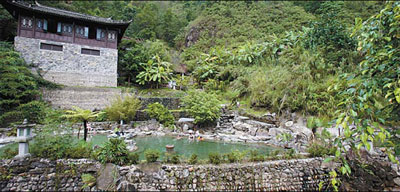Hot springs are a natural feature of Tengchong, Yunnan Province.
We arrived in Tengchong after a 50-minute flight from Kunming, capital of Yunnan Province, to the city of Baoshan, and a four-hour drive on winding mountain paths.
Tired from our journey to this county bordering Myanmar, the surroundings looked like a dreamscape, enveloped in a thick mist, while a distant tower appeared to float in the air and glitter with a golden light.
It is called Wenbi Tower by the locals. Wen bi is a style of writing and implies literary talent. It is said that in ancient times, intellectuals would visit the tower and pray for success before taking the imperial civil exams.
Located to the west of the splendid Gaoligong Mountains, Tengchong has long been overshadowed by other resorts in Yunnan Province - such as Lijiang, Dali and Shangri-La - though it also boasts spectacular scenery.
It is said there are 99 extinct volcanoes and 88 hot springs in Tengchong. A good start to one's visit is relaxing in a hot spring, at night.
There are many hot springs in the area, with names like Toad-mouth Spring, Beauty Spring and Pearl Spring. But the king of them all is, perhaps, Grand Boiling Hot Pot.
It is 6 m in diameter and 1.5 m wide, with a temperature of around 97 C. According to a local tale, a cow once fell into the hot spring and the next day it was a beef broth.
Another fable suggests the area used to be cold and barren and in order to alleviate disease and suffering, a local hero swallowed a magic ball and changed into a golden dragon. Wherever he went, hot springs sprang up and the area flourished.
Today, not only do hot springs generate water to soothe people's muscles and quicken their blood, it is also used for cooking, as staff dig a hole near the spring and put a layer of pine needles on the bottom. They place quail eggs and potatoes in it, which will be cooked in four to six hours.
Another favorite form of relaxation is lying down on pine needles and feel the heat rising from the ground, which makes you sweat and washes your worries away.
Visitors who enjoy culture should visit Heshun, a small village 3 km away from Tengchong, which has clusters of old buildings.
"It is said that we are descendents of the armies of Zhu Yuanzhang, the first emperor of the Ming Dynasty (1368-1644), who came from Northern China and settled down here," Cun Maohong, head of the village, says.
Cun's three-story house halfway up the mountain is a perfect spot to appreciate the idyllic charms of Heshun.
Standing by the third-floor window, visitors will marvel at the landscape unfolding below: The ancient buildings at the foot of Laifeng Mountain, Wenbi Tower, a zigzagging country road paved with volcanic rock, yellow paddy fields, and a pavilion by a crystal-clear river.
Cun says the pavilion was built to protect women from the sun and rain while they washed clothes.
"Morning is one of the best times of day in Heshun. If it is clear you will see the sun rising behind Laifeng Mountain. ... But taking a stroll in the drizzle is equally poetic," Cun says.
(China Daily January 10, 2008)


